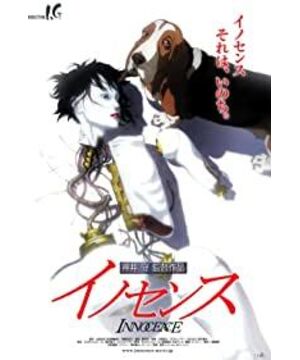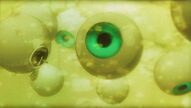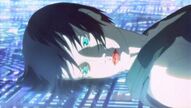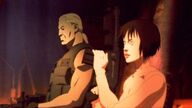Impression of the attack on the shell is well known and understood by most people, and it should have started with the opportunity of "The Matrix". Before shooting the most expensive cult film in history, the Wachowski brothers declared to the world that they would pay tribute to Japanese animation. So, from the fast-moving and shining Japanese katakana on the dark green screen to the data interface behind the neck, they all directly copied the idea of Ghost in the Shell. Since then, the attack on the shell has been like "staining the light", borrowing a ray of east wind from hackers, and wandering into the eyes of the European and American public. If the patchwork of hacking trilogy like a big pot of paste brings people dazzling visual stimulation and challenges; then the Ghost in the Shell series is undoubtedly more direct to people's hearts, giving people a myth.
Picture: gorgeous visual feast
this attack shell Ⅱ a major part, is making a strong charge master group Oshii and IG studio. Its quirky and gorgeous colors, and the ingenious combination of 2D and 3D technology, regardless of the plot setting, is a rare masterpiece from the point of view of visual enjoyment. In order to make viewers feel different from the previous work, this time the theater version has abandoned the previous classic creative direction of green as the main color and boldly used red tones to enhance the atmosphere. This is really true in the series of works of the shell. Rare. Perhaps out of conservative considerations, the combination of green and red is not uncommon in the film (as can be seen from the clothing of the characters), which inadvertently created a major feature of the film.
The production of the film did not deliberately pursue a realistic effect. The coexistence of three-dimensional and flat characters makes many first-time viewers feel a little awkward, but from the perspective of the processing of the picture, this approach will undoubtedly increase the size and momentum of the picture. Sense, the main characters and details will be more clear. The sub-shots mostly borrowed the shooting techniques of movie lenses, but animations are animations after all. In the fragments of the investigation conducted by Togusa and Barthes in the technical research room, the use of the wide-angle lens was not very successful, and it even gave people a sense of rigidity, which can not but be said to be a pity.
The working group really took great pains to grasp the color of the picture. For example, in the opening scene of the robot self-destructing, in order to impress the viewers, the production staff deliberately set the background in a winding and gloomy alley. As Bart approached step by step, the small shops in the alley became thinner and thinner. The light gradually dimmed under the gradual tension of the viewer's mood. At this time, the female robot suddenly appeared at the end of the alley. The white skin and the bright red and exposed kimono contrasted strongly and eye-catchingly. The almost pale color really makes the picture a lot weird, but the white lily dotted around the female doll's ear makes the weird and cute. Such an untimely cuteness may be a sign of her self-destruction.
It is worth mentioning that the scenes of people celebrating during the festival that began at 49 minutes and 44 seconds of the film were not fabricated by the creative team. The costumed performers on the floats were also drawn based on the photos taken during the collection. The colors and the freshness in the lens are extremely luxurious. I wonder if this picture will make the Chinese audience feel cordial. .
As far as the whole work is concerned, gorgeousness goes to gorgeousness, the excessive demanding of the screen production, and the harshness of some plots due to the departure from the original theme, it is inevitable that people feel suspicion of showing off technology.
Episode: sad confusion
"wa me cry wa me cryのGod 々 moo wa me cry wa me cryのhope moo, moo wa ya ta da scientific na mooのでshi ka naiとsu me cry wa, wa me cry wa me cryのlove moo ma ta scientificでthou ~ teいke naiいwa me cry ga thou ri ma shiょぅka"
- ri ra ta nn " Future のィヴ"
"If our gods and hopes have become part of science, will anyone insist that love is not a science?"
-Lier Adam, "Future Eve"
"If our gods and our hops are nothing but scientific phenomena, then it must be said that our love is scientific as well."
——"L'Eve Future"
At the beginning of the film, a philosophical proposition that I am afraid will never be answered, that is, what is the value of human existence, and whether the existence of the body is really the criterion for judging other human beings. The English name of Ghost in the Shell is "Ghost In The Shell". Ghost means soul, that is, human consciousness and thought. Shell is the carrier of consciousness. When the high-tech era comes, humans, robots, and humans (Cyborg) with prosthetic limbs in between coexist in the world. Human thoughts and memories can be input into the cold steel body, and even robots can produce AI, then can the existence of the body still be the criterion for judging humans and machines? The separation of the soul and the body makes the concept more symbolic, leading to a series of questions: the easy transformation of the shell makes immortality easier to achieve, but this will bring a series of confusion: is it a person or a ghost? Ghosts out of the shell, ghosts that exist in the shell, what is the significance of their existence? When the perceptual thinking of human beings will finally be completely formulated, is human beings at this time extinct from a certain level?
This time the protagonist is Bart of the 9th Public Security Department. From the setting point of view, Bart’s appearance is undoubtedly much older than on the TV version. One day, a trial-type girl doll produced by Locus Solus suddenly lost control and self-destructed after killing its owner. In the case of Suzi's mysterious disappearance, Bart and his new partner Togusa immediately launched an investigation. The inexplicable hacker attack after entering the network made the case more complicated. Bart moved to the truth of the incident step by step in the difficult progress of the investigation. In this film, withdrawing from the nine classes of public security, the element of thinking drifting away from the online world also reappears. The philosophical question of "Who am I" was raised. As Bart and Togusa completed their investigation into the murder of the robot doll, not only did it not become clear, but it became even more confusing.
When entering the technical research room to obtain relevant information about the robot doll, the one who received Bart and Togusa was a woman who was nearly 30 years old and had an indifferent attitude. Although this person has only appeared once in the film, for most viewers, she left a very deep impression. Throughout the film, she is undoubtedly the one with the most "human" breath among all the dozens of characters in the film. The propositions put forward by her mouth probably also represent the doubts in the hearts of many viewers: humans and robots are different. But this belief only separates black and white, staying at the level of understanding that humans are not mechanical. She advocates that humans and robots are equal, and this idea is only passed in the film, "The future should be bright." Regarding the concerns that have always been revealed in Shirou Masamune's comics, she is positive and optimistic. The film's utter decadence and desolation is very different from the original work. As a screenwriter, Mamoru Oshii has obviously abandoned one of the original works and only borrowed the story background and character settings from Shirou's authentic manga. This is quite consistent with the style of Mamoru Oshii known as the "original shredder". Oshii Mamoru himself once said: "I will never allow an idyllic protagonist. The current protagonist is absolutely required to hold a more painful theme." It is no wonder that many Shirou's authentic fans will treat Oshii Mamoru. The plot setting is brooding. Audiences who want to get a glimpse of the whole story of Attack on the Shell through this film, I am afraid they will be disappointed.
The artistry of the film is strong, and there are so many quotations in the lines. I watched it all at once. It is inevitable that my thoughts will get stuck. In addition to the weird atmosphere, the film has more obscure meanings, so that some websites are not polite. It is hailed as the most difficult movie to understand since the 21st century. In fact, some of these quotations do refer to them, and some are purely self-entertaining by the author. For viewers who are not too in-depth, it is recommended that they skip the cumbersome quotes first, and then understand the quotes after drilling through the story outline, and may have a deeper understanding of the theme of the film. Those who have seen Shilang's authentic works should all have strong feelings about the supplements that sometimes exceed the number of comics. From history, economics, philosophy, politics and law, physiology, mechanics, to the author’s views on certain current events, the scope of his coverage is so wide that it is horrendous; some chapters do not have any dialogue, relying solely on the reader’s passage of characters The expressions and actions can be figured out on their own. This is not Shiro’s authentic selling of mystery. Although from a commercial point of view, readers prefer to see easy-to-understand articles, Ke Shiro believes that reality is not so easy to understand. He hopes to convey more to people through his "obscure" works. Useful stuff. His works are as low-key as he is. In order to follow the consistent style of manga, Oshii Mamoru also quoted famous lines in many places. According to Oshii Mamoru: "There is almost no language that is not used as a line, so it is better to use the most reasonable sayings of mankind two or three thousand years ago." This may be an explanation for another version of the application language.
"Seeing bird blood is sympathy, and seeing fish blood is ruthless. Fortunately those who have a voice." This sentence that Suzi said to Bart before bidding farewell was a bit confusing. The next paragraph of Suzi may be used as this sentence. The best interpretation: "If the puppets can speak, they will also call out'I don't want to be a human'." This is another ancient philosophical debate, just like the ancient paradox of "a fish". Bart’s task is to find out the manipulator who caused the doll to kill the owner. The final answer is unexpected and reasonable. The murderer is an innocent girl who is unwilling to be illegally extracted by Locus Solus and injected into the body of the doll; Death seems to be forcibly liberated, but Bart is unable to distinguish the attitude of the doll before self-destruction due to the violation of the three laws of robots: is it disgust, or nostalgia? Naturally, he can't completely define the little girl who is still immature and fearful in front of him as a killer. The end of the mission, this result has made new doubts even thicker. The boundary between humans and robots, or hierarchical affiliation, did not have a ready answer until the end of the film. What it leaves to the audience is more difficult and obscure thinking than the film's quotes. When the film raises a huge question, it also hints to the audience: If the existing blurring boundary between man and machine cannot be resolved, then peace will always be an illusion. Under the confusion of high technology, there will always be more crises hidden. The insolvability of this future crisis has been expanded indefinitely by Mamoru Oshii, and the technologically advanced future world seems to be the end of the world.
After completing the investigation with Bart, Mo Zi finally left irresistibly and reintegrated his consciousness into the network. In order to highlight the theme, the dim love between Bart and Motoko is destined to only become a small lace that spreads through Oshii Mamoru's pen. Motoko can only pass by like a stranger when Bart is attacked by hackers, gently reminding " Stepped into the Asura Field", but he couldn't stop Bart's misfortune of making five shots into his arm. The robot that input Mozi's consciousness crashed down after exhaustion of energy. The body that had existed as Mozi no longer existed, and her consciousness returned to nothingness again, existing in the Internet, everywhere. The doll collapsed into ruins and the elemental consciousness left, building a bridge between reality and illusion. The unbelievable truth repeats itself before Bart's eyes. The gray brushstrokes and sad worldview of the film, with the fall of the cold body, once again enveloped the whole picture.
The end of the movie is full of human touch relative to the whole movie. After dozens of days away from the owner, the hound raised by Bart saw the owner return. After shaking his head and tailing, he rushed into Bart’s arms, and Togusa was finally able to get the most out of him. Worried wife and daughter reunited. Against this background, Oshii Mamoru did not forget to push his sense of worry into the picture: The blue eyes of the doll in the arms of Togusa's daughter flashed with determination and worry like a sign of Suzi.
She stared at everything in the darkness, sighing softly, her breath flowing like wind.
Music: the sound of the crashing scene ethereal atmospheric
soundtrack of the movie still worked with Mamoru Oshii the "Ghost in the Shell" of Kenji Kawai surgeon, Ghibli (Gibb force studio) third-party production. The theme song "Follow Me" is based on the 20th century Spanish representative composer Joaquin Rodrico's concerto "Aranfis Concerto" arranged by the jazz singer Ito Junzi, the magnificent visual impact is nearing the end, in a black In the background, the melody of "Follow Me" sounded leisurely, as if it were natural.
DVD Release: hasty exquisite
movie released soon, DVD launched very rapidly, at first glance is a bit hasty, but the packaging is beautiful to see. In terms of sound quality, due to the D9 input, the six-channel performance is quite smooth, especially the heavy bass sound effect of the opening helicopter flying over the city, which is definitely a good test machine. The most exaggerated thing is that this film actually released four versions of DVD in one go. It has the meaning of allowing investors to recover their funds happily.
1. Standard version (double disc): Except for the DTS-ES audio tracks of the other three versions, the basic content and highlights have been included. Issued in September 2004.
2. Dog box limited edition: limited to 15,000 sets, the dog box is personally supervised and built by Mamoru Oshii, weighing 890 grams. Issued in September 2004.
3. Limited Edition Volume 2: Limited to 15,000 sets, with three books included: comic version, initial script and final script, released in September 2004.
4. Collector's Edition (five discs): Contains the feature film with DTS and the side-by-side discs in the standard edition. The other three discs contain a four-hour documentary, which involves editing, sound effects, publicity, and the Cannes Film Festival, etc. aspect. The set also comes with a 40 cm tall doll, a 240-page book titled "Oshii Mamoru Design Collection" and an "INNOCENE Official Art Book", released in October 2004.
http://www.bulaoge.com/topic.blg?tuid=4451&tid=613238
View more about Ghost in the Shell 2: Innocence reviews











